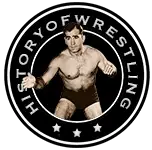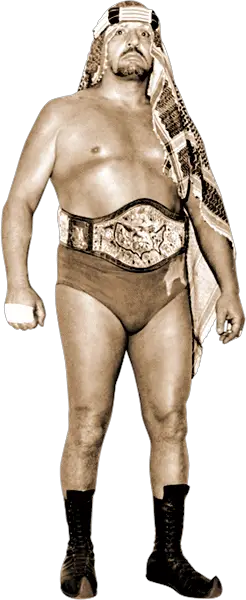by Stephen Von Slagle
Perhaps no other wrestler is more responsible for influencing the genre of hardcore wrestling than the one and only Arabian madman known as The Sheik. Famous worldwide for being the most unpredictable, violent, bloodthirsty competitor in pro wrestling, The Sheik was “hardcore” decades before anyone had come up with a term to describe his style. Simply put, if The Sheik was wrestling, fans of the day knew, without any question, that they were going to see a bloodbath. His maniacal persona, not to mention his penchant for participating in overly gruesome, ultra-violent matches, set a standard that hardcore wrestlers are still trying to equal, some 70 years after his debut.
 Edward Farhat was born on June 7, 1926, the son of Lebanese parents. After attending Michigan State University, he began his career wrestling for Fred Kohler’s Chicago-based promotion in the early 1950s. Known as the Sheik of Araby, the privileged son of a wealthy aristocratic Middle Eastern family, he was one of the great early “TV wrestling” villains on the Dumont network. At the time, the young Farhat was trim, in shape and, with his controversial handler Abdullah Farouk (Ernie Roth), very good at getting under the fans’ skin. Adorned in his traditional Arabian headdress, wearing his famous pointed-tip wrestling boots and carrying a ceremonial sword to the ring, his pre-match ritual of laying a Persian prayer rug in the ring and bowing to Allah was a controversial heat-generator. From the start, The Sheik was truly a unique wrestling character who quickly established himself as a top box office draw for promoters of the day. There were many reasons for The Sheik’s success, none of which, admittedly, had anything to do with actual technical wrestling skills, of which he displayed virtually none. Obviously, his infamous bloodlust and pencil-wielding penchant for gore and brutality were calling cards that fans everywhere were well aware of. Additionally, he originated the “fire throwing” gimmick, which was later copied by countless others, and he was the first wrestler to bring a live snake with him to the ring. But, most importantly, The Sheik literally never broke character, truly living his gimmick and keeping a legitimate air of mystery about him at all times.
Edward Farhat was born on June 7, 1926, the son of Lebanese parents. After attending Michigan State University, he began his career wrestling for Fred Kohler’s Chicago-based promotion in the early 1950s. Known as the Sheik of Araby, the privileged son of a wealthy aristocratic Middle Eastern family, he was one of the great early “TV wrestling” villains on the Dumont network. At the time, the young Farhat was trim, in shape and, with his controversial handler Abdullah Farouk (Ernie Roth), very good at getting under the fans’ skin. Adorned in his traditional Arabian headdress, wearing his famous pointed-tip wrestling boots and carrying a ceremonial sword to the ring, his pre-match ritual of laying a Persian prayer rug in the ring and bowing to Allah was a controversial heat-generator. From the start, The Sheik was truly a unique wrestling character who quickly established himself as a top box office draw for promoters of the day. There were many reasons for The Sheik’s success, none of which, admittedly, had anything to do with actual technical wrestling skills, of which he displayed virtually none. Obviously, his infamous bloodlust and pencil-wielding penchant for gore and brutality were calling cards that fans everywhere were well aware of. Additionally, he originated the “fire throwing” gimmick, which was later copied by countless others, and he was the first wrestler to bring a live snake with him to the ring. But, most importantly, The Sheik literally never broke character, truly living his gimmick and keeping a legitimate air of mystery about him at all times.
 Another factor in The Sheik’s immense fame and notoriety came from the fact that he wrestled in territories covering the entire nation at a time when wrestling was very regionalized. The Sheik was also a true world traveler and he performed in nearly every country that had a following for pro wrestling. His wild, gory battles with archrival Bobo Brazil, as well as Terry Funk, Antonino Rocca, Johnny Valentine, Bruno Sammartino, Dick the Bruiser, Mark Lewin, Fred Blassie and Harley Race were the stuff of legend, not to mention box office gold. The Sheik also had a bizarre and bloody decades-long love/hate relationship with the only man who could ever lay serious claim to his title as the “Most Vicious Man In Wrestling,” Abdullah the Butcher. With Abdullah’s fork in hand, and The Sheik with his pencil, the two wrestling madmen ripped and tore into each other in arenas around the world with a furor and vengeance nearly unparalleled in the history of wrestling. The point of contention was simple; who was the more violent, more insane, more extreme wrestler between the two. In a strange, twisted sort of way, the Abdullah vs. Sheik bouts were battles of honor, respect and pride…with a truckload of foreign objects and many gallons of blood poured in for good measure. Additionally, when paired together, which was a semi-frequent occurrence over the years, the team of The Sheik and Abdullah was a legitimately frightening duo for whomever was unlucky enough to be facing them.
Another factor in The Sheik’s immense fame and notoriety came from the fact that he wrestled in territories covering the entire nation at a time when wrestling was very regionalized. The Sheik was also a true world traveler and he performed in nearly every country that had a following for pro wrestling. His wild, gory battles with archrival Bobo Brazil, as well as Terry Funk, Antonino Rocca, Johnny Valentine, Bruno Sammartino, Dick the Bruiser, Mark Lewin, Fred Blassie and Harley Race were the stuff of legend, not to mention box office gold. The Sheik also had a bizarre and bloody decades-long love/hate relationship with the only man who could ever lay serious claim to his title as the “Most Vicious Man In Wrestling,” Abdullah the Butcher. With Abdullah’s fork in hand, and The Sheik with his pencil, the two wrestling madmen ripped and tore into each other in arenas around the world with a furor and vengeance nearly unparalleled in the history of wrestling. The point of contention was simple; who was the more violent, more insane, more extreme wrestler between the two. In a strange, twisted sort of way, the Abdullah vs. Sheik bouts were battles of honor, respect and pride…with a truckload of foreign objects and many gallons of blood poured in for good measure. Additionally, when paired together, which was a semi-frequent occurrence over the years, the team of The Sheik and Abdullah was a legitimately frightening duo for whomever was unlucky enough to be facing them.
Despite the fact that bloodletting, not acquiring championships, was his primary goal as a wrestler, The Sheik was nevertheless a winner and he collected more than his fair share of title belts. He was known primarily as the perennial United States Heavyweight champion (Detroit version) by virtue of his twelve separate U.S. title victories, which The Sheik acquired between 1965-1980. However, he also wore the WWWF, Central States, Maple Leaf Wrestling and I.C.W. versions of United States title as well. In 1969, he defeated archrival Bobo Brazil for the NWA Americas Heavyweight title, only to lose it to another of his many bitter rivals, “Classy” Fred Blassie. The Sheik regained the strap from Blassie, but held it for a relatively short time before losing to the legendary luchador, Mil Mascaras. Internationally, he defeated Seiji Sakaguchi for the prestigious United National Heavyweight championship on September 6, 1972, in Tokyo.
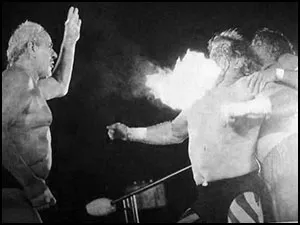 In addition to his overwhelming success wrestling in promotions all across the globe, Ed Farhat developed a healthy, profitable regional NWA territory in Michigan. With Detroit as its base of operations, Farhat’s “Big Time Wrestling” TV program and the group’s live events (which also covered parts of Ohio and Ontario) were a major part of the NWA’s territorial structure between 1964-1980. During the early 1970s, Detroit was unquestionably one of the top territories in the NWA, and The Sheik’s promotion was the subject of the classic quasi-documentary, “I Like To Hurt People.” In addition to bringing in top talent to the promotion, Farhat also had a hand in training and developing many of his own young performers, including future superstars like his nephew Sabu, Rob Van Dam, and Scott Steiner, as well as young independent stars like “Machine Gun” Mike Kelly.
In addition to his overwhelming success wrestling in promotions all across the globe, Ed Farhat developed a healthy, profitable regional NWA territory in Michigan. With Detroit as its base of operations, Farhat’s “Big Time Wrestling” TV program and the group’s live events (which also covered parts of Ohio and Ontario) were a major part of the NWA’s territorial structure between 1964-1980. During the early 1970s, Detroit was unquestionably one of the top territories in the NWA, and The Sheik’s promotion was the subject of the classic quasi-documentary, “I Like To Hurt People.” In addition to bringing in top talent to the promotion, Farhat also had a hand in training and developing many of his own young performers, including future superstars like his nephew Sabu, Rob Van Dam, and Scott Steiner, as well as young independent stars like “Machine Gun” Mike Kelly.
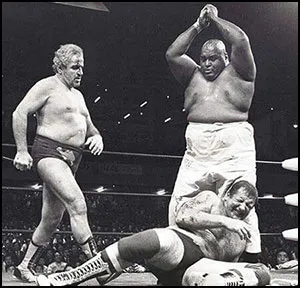 However, despite its many years of success, as the owner, booker and featured star of the promotion, Farhat’s group eventually became stale, with repetitive booking burning-out its once large audience. Additionally, a frequent history of false advertising and no-shows on major cards certainly did not help the situation. Meanwhile, the fiercely independent Farhat alienated many of his fellow promoters within the NWA, causing ongoing problems between himself and the Alliance during the late 1970s. In 1980, following several years of declining business and the crippling loss of its television outlet, Big Time Wrestling folded. However, despite the loss of his promotion and even as he passed the age of 50, then 60, and reached 70, The Sheik continued to be a force within professional wrestling. While competing in Atushi Onita’s ultra-violent Frontier Martial Arts promotion in 1992, The Sheik defeated Onita in Tokyo for the F.M.W. Martial Arts championship at the age of 66. He also appeared in ECW (then known as Eastern Championship Wrestling) briefly in 1994. Then, in 1998, forty-nine years after he first began his career, The Sheik wrestled his final match in Japan at the age of 72.
However, despite its many years of success, as the owner, booker and featured star of the promotion, Farhat’s group eventually became stale, with repetitive booking burning-out its once large audience. Additionally, a frequent history of false advertising and no-shows on major cards certainly did not help the situation. Meanwhile, the fiercely independent Farhat alienated many of his fellow promoters within the NWA, causing ongoing problems between himself and the Alliance during the late 1970s. In 1980, following several years of declining business and the crippling loss of its television outlet, Big Time Wrestling folded. However, despite the loss of his promotion and even as he passed the age of 50, then 60, and reached 70, The Sheik continued to be a force within professional wrestling. While competing in Atushi Onita’s ultra-violent Frontier Martial Arts promotion in 1992, The Sheik defeated Onita in Tokyo for the F.M.W. Martial Arts championship at the age of 66. He also appeared in ECW (then known as Eastern Championship Wrestling) briefly in 1994. Then, in 1998, forty-nine years after he first began his career, The Sheik wrestled his final match in Japan at the age of 72.
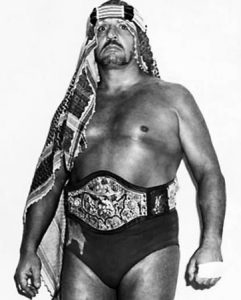 During his five decades in professional wrestling, The Sheik not only created a “Mad Arab” character that has been emulated many times over, but he also set a standard of violence and mayhem inside the ring that few have ever been able to match. Consequently, he will forever go down in history as one of the most important wrestling figures of the late twentieth century. As such, The Sheik is a member of the Wrestling Observer Newsletter Hall of Fame (1996), the WWE Hall of Fame (2007), the NWA Hall of Fame (2010) and the Professional Wrestling Hall of Fame and Museum (2011).
During his five decades in professional wrestling, The Sheik not only created a “Mad Arab” character that has been emulated many times over, but he also set a standard of violence and mayhem inside the ring that few have ever been able to match. Consequently, he will forever go down in history as one of the most important wrestling figures of the late twentieth century. As such, The Sheik is a member of the Wrestling Observer Newsletter Hall of Fame (1996), the WWE Hall of Fame (2007), the NWA Hall of Fame (2010) and the Professional Wrestling Hall of Fame and Museum (2011).
On January 18, 2003, Edward “The Sheik” Farhat passed away due to heart failure at the age of 76.
